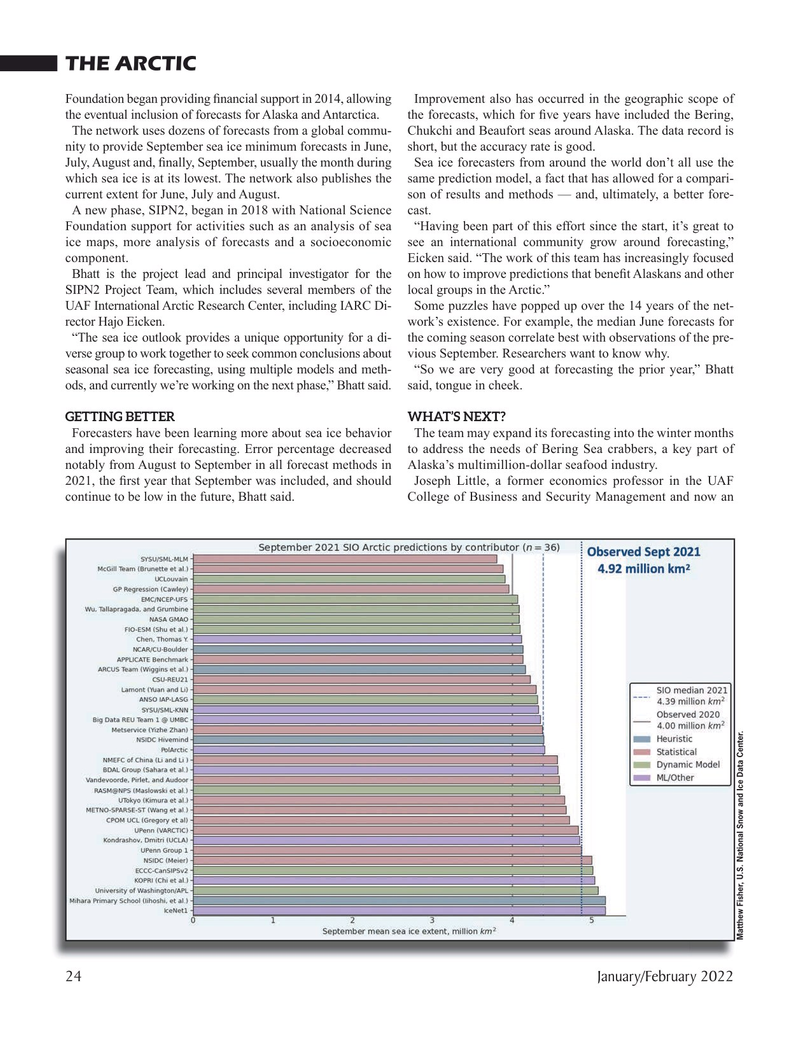
Page 24: of Marine Technology Magazine (January 2022)
Read this page in Pdf, Flash or Html5 edition of January 2022 Marine Technology Magazine
THE ARCTIC
Foundation began providing ? nancial support in 2014, allowing Improvement also has occurred in the geographic scope of the eventual inclusion of forecasts for Alaska and Antarctica. the forecasts, which for ? ve years have included the Bering,
The network uses dozens of forecasts from a global commu- Chukchi and Beaufort seas around Alaska. The data record is nity to provide September sea ice minimum forecasts in June, short, but the accuracy rate is good.
July, August and, ? nally, September, usually the month during Sea ice forecasters from around the world don’t all use the which sea ice is at its lowest. The network also publishes the same prediction model, a fact that has allowed for a compari- current extent for June, July and August. son of results and methods — and, ultimately, a better fore-
A new phase, SIPN2, began in 2018 with National Science cast.
Foundation support for activities such as an analysis of sea “Having been part of this effort since the start, it’s great to ice maps, more analysis of forecasts and a socioeconomic see an international community grow around forecasting,” component. Eicken said. “The work of this team has increasingly focused
Bhatt is the project lead and principal investigator for the on how to improve predictions that bene? t Alaskans and other
SIPN2 Project Team, which includes several members of the local groups in the Arctic.”
UAF International Arctic Research Center, including IARC Di- Some puzzles have popped up over the 14 years of the net- rector Hajo Eicken. work’s existence. For example, the median June forecasts for “The sea ice outlook provides a unique opportunity for a di- the coming season correlate best with observations of the pre- verse group to work together to seek common conclusions about vious September. Researchers want to know why.
seasonal sea ice forecasting, using multiple models and meth- “So we are very good at forecasting the prior year,” Bhatt ods, and currently we’re working on the next phase,” Bhatt said. said, tongue in cheek.
GETTING BETTER WHAT’S NEXT?
Forecasters have been learning more about sea ice behavior The team may expand its forecasting into the winter months and improving their forecasting. Error percentage decreased to address the needs of Bering Sea crabbers, a key part of notably from August to September in all forecast methods in Alaska’s multimillion-dollar seafood industry.
2021, the ? rst year that September was included, and should Joseph Little, a former economics professor in the UAF continue to be low in the future, Bhatt said. College of Business and Security Management and now an
Matthew Fisher, U.S. National Snow and Ice Data Center.
24 January/February 2022
MTR #1 (18-33).indd 24 1/25/2022 9:56:35 AM

 23
23

 25
25
